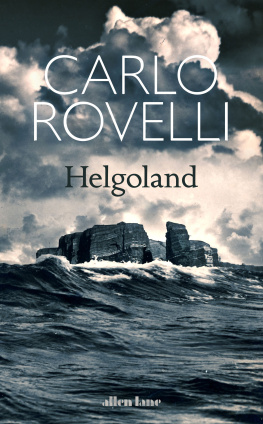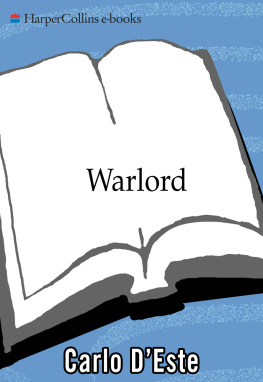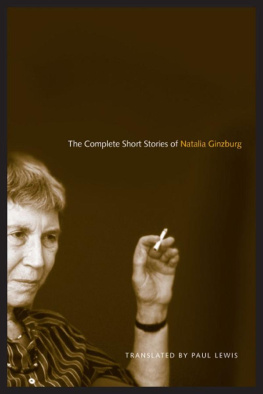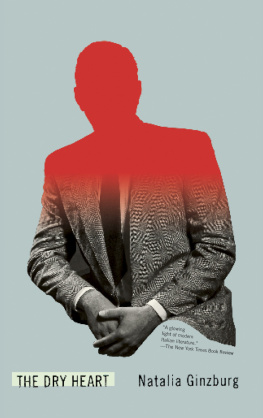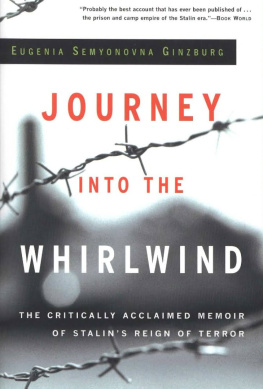Ginzburg Carlo - Threads and Traces
Here you can read online Ginzburg Carlo - Threads and Traces full text of the book (entire story) in english for free. Download pdf and epub, get meaning, cover and reviews about this ebook. publisher: University of California Press, genre: Detective and thriller. Description of the work, (preface) as well as reviews are available. Best literature library LitArk.com created for fans of good reading and offers a wide selection of genres:
Romance novel
Science fiction
Adventure
Detective
Science
History
Home and family
Prose
Art
Politics
Computer
Non-fiction
Religion
Business
Children
Humor
Choose a favorite category and find really read worthwhile books. Enjoy immersion in the world of imagination, feel the emotions of the characters or learn something new for yourself, make an fascinating discovery.

- Book:Threads and Traces
- Author:
- Publisher:University of California Press
- Genre:
- Rating:4 / 5
- Favourites:Add to favourites
- Your mark:
- 80
- 1
- 2
- 3
- 4
- 5
Threads and Traces: summary, description and annotation
We offer to read an annotation, description, summary or preface (depends on what the author of the book "Threads and Traces" wrote himself). If you haven't found the necessary information about the book — write in the comments, we will try to find it.
Threads and Traces — read online for free the complete book (whole text) full work
Below is the text of the book, divided by pages. System saving the place of the last page read, allows you to conveniently read the book "Threads and Traces" online for free, without having to search again every time where you left off. Put a bookmark, and you can go to the page where you finished reading at any time.
Font size:
Interval:
Bookmark:
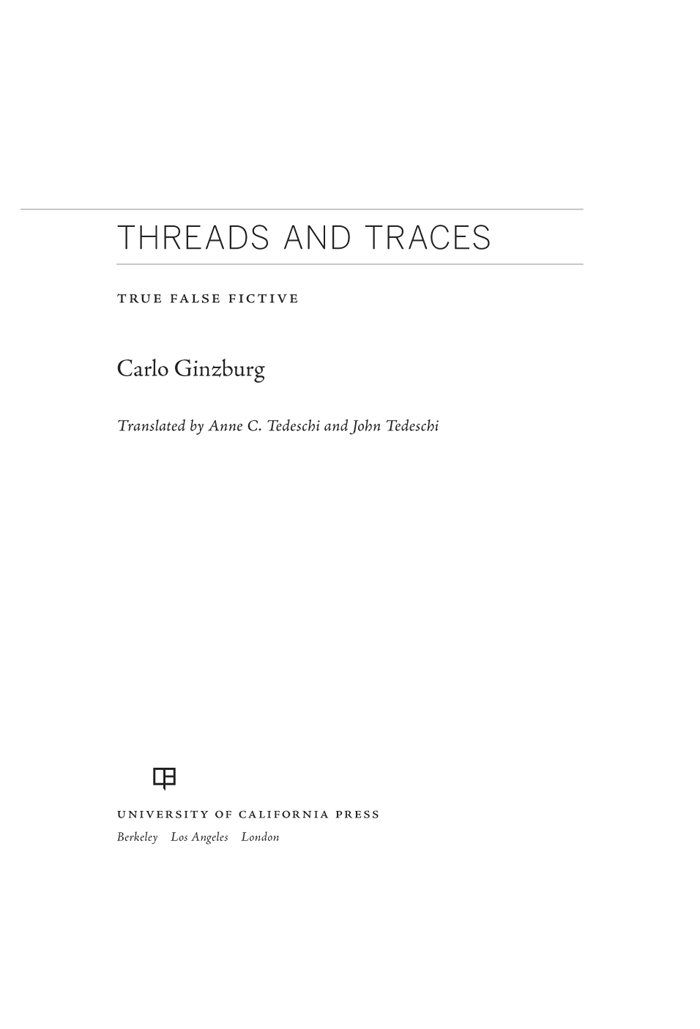
THREADS AND TRACES
The publisher gratefully acknowledges the generous support of the Ahmanson Foundation Humanities Endowment Fund of the University of California Press Foundation.
The publication of the present book was made possible by the contribution of the Italian Ministry of Foreign Affairs.
TRUE FALSE FICTIVE
Carlo Ginzburg
Translated by Anne C. Tedeschi and John Tedeschi

University of California Press, one of the most distinguished university presses in the United States, enriches lives around the world by advancing scholarship in the humanities, social sciences, and natural sciences. Its activities are supported by the UC Press Foundation and by philanthropic contributions from individuals and institutions. For more information, visit www.ucpress.edu.
University of California Press
Berkeley and Los Angeles, California
University of California Press, Ltd.
London, England
2012 by The Regents of the University of California
Library of Congress Cataloging-in-Publication Data
Ginzburg, Carlo.
[Filo e le tracce. English]
Threads and traces : true, false, fictive / Carlo Ginzburg;
translated by Anne C. Tedeschi and John Tedeschi. 1
p. cm.
Includes bibliographical references and index.
ISBN 978-0-520-25961-4 (cloth : alk. paper)
1. HistoriographyPhilosophy. 2. Literature and
history. 3. HistoryErrors, inventions, etc.
4. Truth. 5. Collective memory. I. Title.
D16.8.G536513 2012
907.2dc23
2011020079
Manufactured in the United States of America
20 19 18 17 16 15 14 13 12
10 9 8 7 6 5 4 3 2 1
In keeping with a commitment to support environmentally responsible and sustainable printing practices, UC Press has printed this book on Rolland Enviro100, a 100 percent postconsumer fiber paper that is FSC certified, deinked, processed chlorine-free, and manufactured with renewable biogas energy. It is acid-free and EcoLogo certified.
1. The Greeks tell us that Theseus received a thread as a gift from Ariadne. With that thread he found his bearings in the labyrinth, located the Minotaur, and slew him. The myth says nothing about the traces that Theseus left as he made his way through the labyrinth.
What holds together the chapters of this book dedicated to some highly heterogeneous topics is the relation between the threadthe thread of narration, which helps us to orient ourselves in the labyrinth of realityand the traces. But in those days historians did not speak of traces and the trail they leave.
It seemed to me that the documents on which I was working (inquisitorial trials) opened a broad range of narrative possibilities. The tendency to experiment in that direction, which also sprang from my family background, found both encouragement and limits in the sources. But I was persuaded (and still am today) that between testimonies, both narrative and nonnarrative, and the reality to which they bear witness there exists a relationship that needs to be analyzed from time to time. The possibility that someone could radically put in doubt that relation did not even enter my mind.
All this is part of the prehistory of the present book. In the second half of the 1960s the climate began to change. Some time later it was announced with great fanfare that historians write. I remember at first remaining indifferent to the hyperconstructionist (and, in fact, skeptical) implications of that revelation. It shows up in a passage of my essay Spie (1979), which considers the connection between deciphering traces and narration without mentioning any eventual skeptical objections. The turning point came for me only when, thanks to an essay of Arnaldo Momiglianos, I realized the moral and political (as well as cognitive) implications of the thesis that basically canceled the distinction between historical and fictional narrations. The afterword that I wrote (1984) for the Italian translation of Natalie Daviss The Return of Martin Guerre (see chapter 4) registers that somewhat belated awareness.
Those pages might be the place to begin reading the present book since they outline a program of study and its polemical objective. Or, more precisely, its inverse, the pars destruens came first, as is perhaps always the case. Against the tendency of postmodern skepticism to blur the borders between fictional and historical narrations, in the name of the constructive element they share, I proposed a view of the relation between the two as a competition for the representation of reality. But rather than trench warfare, I hypothesized a conflict made up of challenges and reciprocal, hybrid borrowings. If this was how things stood, one could not combat neoskepticism by going back to old certitudes. We have to learn from the enemy in order to oppose it more efficaciously.
These are the hypotheses which, in the course of twenty years, have oriented the studies included in this volume.seem less strident and less confident: the winds of fashion may already be blowing from another quarter, but it does not matter. The difficulties ensuing from that discussion and the attempts to resolve them remain.
3. The skeptical attack on the scholarly nature of historical narrations has emphasized their subjectivity, which allegedly likens them to fictional narratives. Historical narratives speak to us less about reality than they do about whoever has constructed them. It is useless to object that a constructive element is present to some extent even in the so-called hard sciences: they, too, have been the object of similar criticism. Against the positivist skepticism that cast doubt on the believability of one document or another, Bloch offered, on the one hand, involuntary testimonies, and on the other, the possibility of isolating within voluntary testimonies an involuntary, hence deeper, core.
Against the radically antipositivist skepticism which attacks the reliability of texts as such, one can use a line of argument that is in some way analogous to Blochs. By digging into the texts, against the intentions of whoever produced them, uncontrolled voices can be made to emerge: for example, those of the women or men who, in witchcraft trials, eluded the stereotypes suggested by the judges. In medieval romances we can trace involuntary historical testimonies relating to habits and customs, isolating fragments of truth within the fiction. This is a discovery that today seems to us almost banal, but toward the midseventeenth century, in Paris, when it was explicitly formulated for the first time (chapter 5), it had a paradoxical ring to it. This was a research strategy not too different from the one Bloch describes concerning the lives of early medieval saints. In the long run, the gap opened up by this simultaneously detached and participatory attitude toward the literature of the past had unpredictable results. Three centuries later, we find the great scholar Erich Auerbach taking a similar path in his analysis of Voltaire and Stendhal when he read the Lettres philosophiques and Le Rouge et le Noir not as historical documents but as texts impregnated with history. Interpretation is infinite, even though its contents are not unlimited: Auerbachs interpretations can be read in a different perspective, following the intentions and the perspective of their author, by making use of the traces that he himself left more or less involuntarily (chapters 7 and 10). Fiction, fed by history, becomes material for historical reflection or else for fiction, and so on. This unpredictable intermingling can come together in a knot, or in a name (chapter 9).
Font size:
Interval:
Bookmark:
Similar books «Threads and Traces»
Look at similar books to Threads and Traces. We have selected literature similar in name and meaning in the hope of providing readers with more options to find new, interesting, not yet read works.
Discussion, reviews of the book Threads and Traces and just readers' own opinions. Leave your comments, write what you think about the work, its meaning or the main characters. Specify what exactly you liked and what you didn't like, and why you think so.



